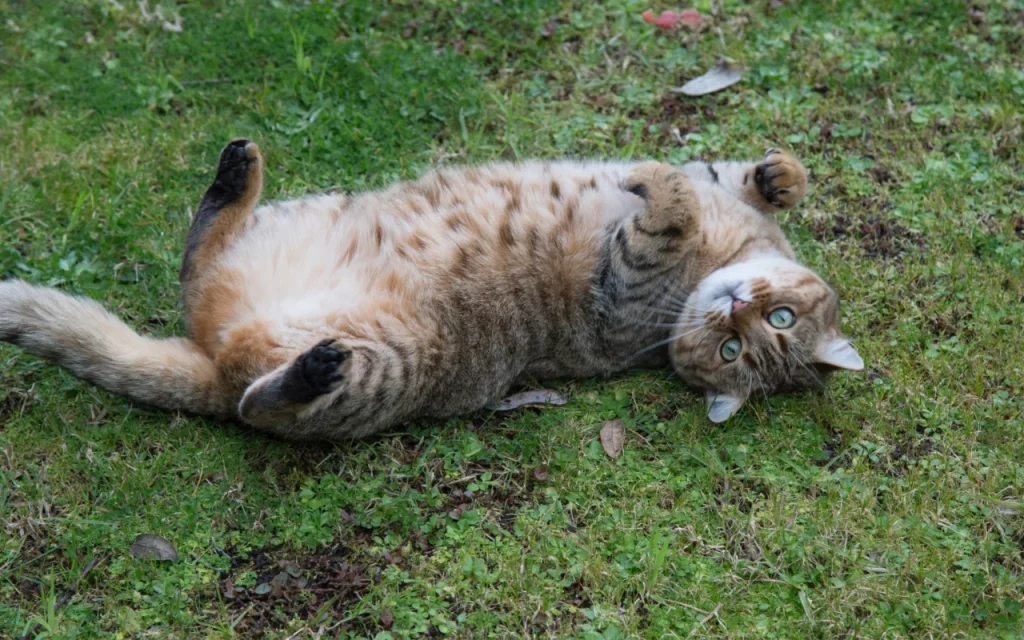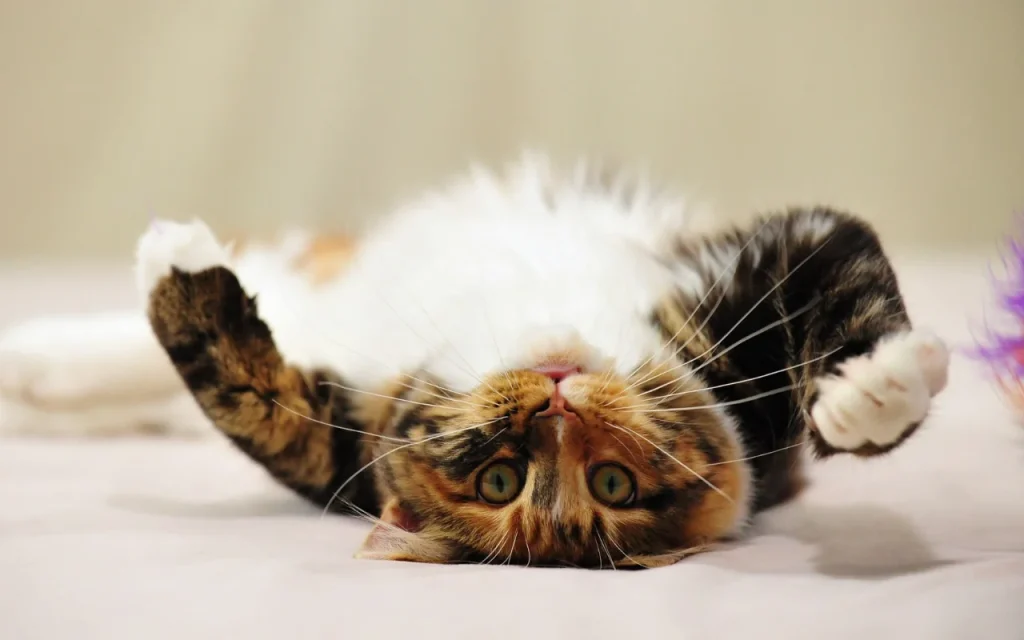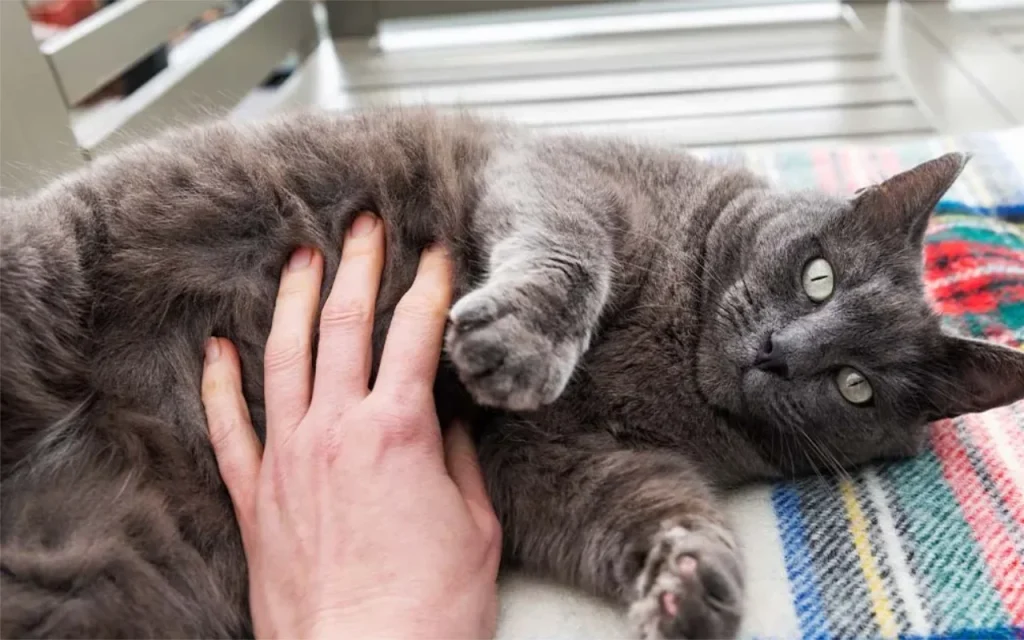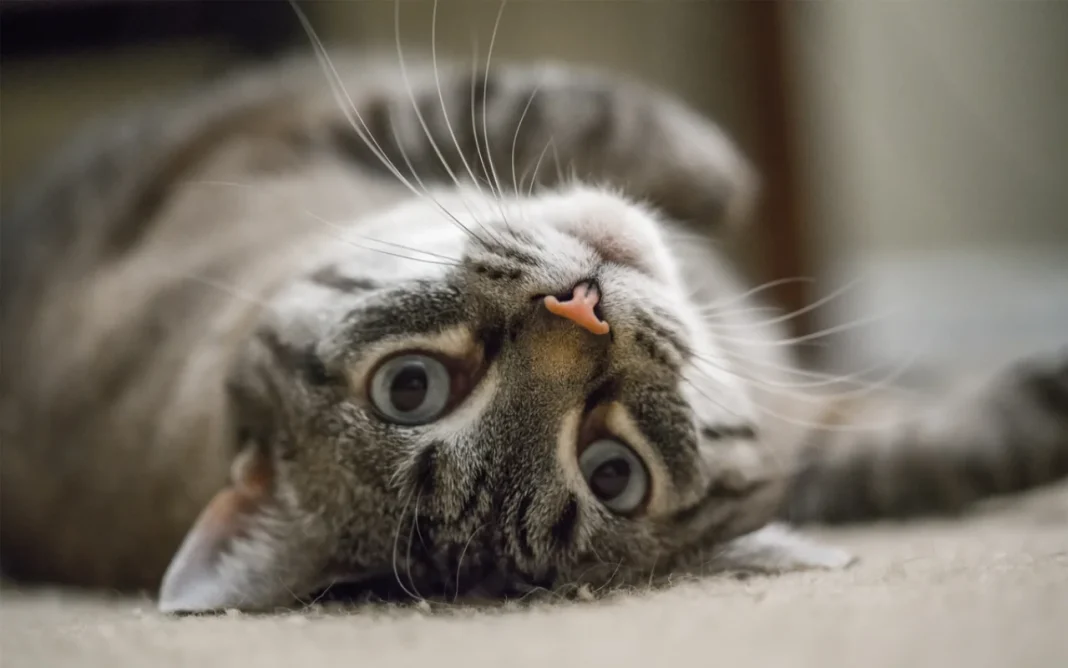Oh, you know that move, don’t you? That utterly charming, sometimes totally confusing thing cats do? One minute they’re all regal, strolling in, maybe they even grace you with a slow, sleepy blink. Next thing, thwump – they’ve flopped right over, legs akimbo, showing off that wonderfully fluffy tum. Your heart just goes ‘awww,’ and you’re probably thinking, ‘They must really trust me! Perfect time for a belly rub!’ So, you reach down, all hopeful for a bit of soft tummy time, and then – BAM! Out come the claws, maybe a cheeky little bat of the paw. If you’ve ever been caught in that furry, adorable ambush, believe me, you’ve got plenty of company in the ‘what just happened?’ club!
As a vet, I’ve heard this story countless times, often accompanied by a bewildered, “But why show me the belly if I can’t touch it?!” It’s a fantastic question, and the answer lies deep in the fascinating world of cat communication and instinct. That belly-up pose isn’t always the open invitation we humans might interpret it to be. There are actually quite a few vet-reviewed reasons – probably at least seven good ones! – why they do the roll, and why that tummy often remains a “no-go zone.”
So, let’s unravel this delightful feline conundrum together.
The Great Cat Belly Conundrum: An Invitation or a Carefully Laid “Trap”?
First off, when a cat rolls onto their back and shows you that glorious expanse of fur, it is often a huge compliment!

Here’s a little something to chew on: out in the wild, or even just in the grand scheme of ‘animal body design,’ that soft belly area? It’s pretty much Mission Control for all their important insides, without a lot of built-in armor. So, when your cat decides to show you that part, to just lie there with everything exposed, it’s usually a huge vote of confidence. They’re basically saying, ‘With you around, in this spot, I feel safe enough to let my guard down completely.’ That’s no small thing; it’s a real testament to the bond you share, a truly lovely signal.
They might also just be having a really good stretch and feeling comfortable. Imagine how good a big stretch feels when you wake up – cats get that too! Rolling around can help them get a nice spinal stretch and just generally feel good. And sometimes, especially on a warm day or a sunny spot on the floor, rolling over can be a way for them to cool down a bit, exposing the less densely furred skin of their belly to the air.
Decoding That Adorable Back-Roll: More Than Just a Cute Pose
Beyond trust and comfort, that roll can have a few other meanings, depending on the cat and the situation:
Sometimes that whole roll-over routine is just pure, unadulterated ‘C’mon, let’s play!’ You’ll often see it with a bit of a wiggle, maybe their eyes go all wide and mischievous, and that tail might start twitching with excitement. It’s like they’re shouting, ‘I’ve got the zoomies in my toes, let’s have some fun!’ Little kittens and sprightly young cats? Oh yeah, this is prime playtime language for them.
And let’s not forget, our cats are seriously clever little things, aren’t they? They’re like furry little scientists, always figuring out what makes us humans tick. If they’ve discovered that doing an adorable roly-poly on the floor makes you stop what you’re doing and go ‘Awww!’ or even just glance their way, well, guess what? They’ve just added a very effective ‘get human’s attention right now’ button to their repertoire!
Now, there’s a particular situation where you might see a lot of rolling, and it’s a bit different: if you have a female cat who isn’t spayed and she’s ‘in heat’ (or ‘in season,’ as some folks say – vets call it estrus). She might suddenly be doing a whole lot more rolling on the floor, often with some pretty loud purring or very distinct meows. That’s all part of her natural ‘Yoo-hoo, any interested boy cats out there?’ mating dance. So, if your unspayed girl suddenly turns into a rolling, extra-cuddly, yowling machine, a chat with your vet about getting her spayed is definitely a good plan.
And here’s a slightly surprising one: while it looks like the ultimate surrender, that belly-up position, paradoxically, can also be a defensive posture. Think about it – if a cat is on their back, all four paws, complete with sharp claws, and their teeth are perfectly positioned to fend off an attacker. Now, in a relaxed home environment with a trusted human, this is rarely the primary reason they’re rolling over for you, but that underlying instinct is still there.

The “Look, But Definitely Don’t Touch!” Tummy: Why It’s So Often Off-Limits
So, if they’re showing you their belly as a sign of trust or playfulness, why the sudden transformation into a tiny, furry ninja if you try to go in for a pat?
- Ultimate Vulnerability: As we said, that belly protects all their vital organs. Even if they trust you enough to show it to you, the ingrained, ancient instinct to protect that vulnerable area is incredibly strong. An unexpected hand moving towards it can trigger a defensive reaction, even if they don’t consciously mean to scratch you. It’s just pure reflex for many cats.
- It’s Super Sensitive (and Maybe Ticklish!): The skin and fur on a cat’s belly are often much thinner and more sensitive than on their back or head. Some cats are genuinely very ticklish there, or the sensation of being touched on their belly just feels overwhelming or unpleasant to them.
- A Learned Response: If a cat has had a negative experience in the past with having their tummy touched – maybe someone was a bit too rough, or they were startled – they might learn to preemptively defend that area.
- Here’s a really biggie, probably the main reason for all that ‘show-but-don’t-touch’ confusion: that belly reveal? It’s often a massive, profound statement of trust, like them saying, ‘See? I feel so chilled out and safe with you right here, right now, that I can totally show you my soft, vulnerable undercarriage.’ But, and it’s a crucial ‘but,’ that beautiful display doesn’t always come with a footnote saying, ‘And now, human, you have full permission to dive in for a belly rub.’ For a whole lot of cats, just showing you the belly is the compliment, the ultimate sign of trust. The actual touching part? That can suddenly feel like a boundary crossed, popping that lovely bubble of safety they were just enjoying.
So, Can I Ever Rub That Adorable Belly? Reading the Feline Fine Print
Now, this doesn’t mean no cat ever enjoys a gentle tummy rub. Some absolutely do! But it’s all about knowing your individual cat and being an expert in reading their very subtle signals.
- The True Invitation: Some cats will genuinely offer their belly for a rub. They might stay completely relaxed, purr, maybe even gently “air knead” with their paws when you touch them there. Their eyes will be soft, their body loose.
- Start Slow and Gentle: If you think your cat might be open to it, always approach super slowly and gently. Offer just one or two light strokes.
- So, if you do decide to brave a gentle tummy pat, you need to become a super-observer, watching for the tiniest, quickest shift in their mood. I mean, a literal nanosecond of change. The very instant you spot any little hint that they’re not entirely loving it – maybe their body just tenses up a fraction, or their ears do a tiny little swivel or flatten out, or that tail gives a sharp little flick, or their eyes just widen a hair – that’s your cue to hit the brakes. Stop. Right then. And then slowly, no sudden movements, take your hand away. They’re giving you a very clear, if subtle, message: ‘Right, that’s my limit for today,’ or maybe just a polite, ‘Hmm, not really feeling the tummy rubs right now, thanks.’
- Respect Their “No”: If they swat, scratch, or try to grab your hand, that’s a very clear “no.” Don’t push it. You’ll just erode their trust.
- Most Cats Prefer Other Spots: Honestly, the vast majority of cats much prefer being petted on their head, cheeks, under their chin, or sometimes at the base of their tail. Stick to their known “yes” zones for the most part, and you’ll both be happier!

Understanding this quirky “show, don’t touch” belly behavior is all part of deciphering the wonderfully complex language of our feline friends. It’s a beautiful mix of trust, instinct, and individual personality. So next time your cat does that adorable floor-flop, appreciate the incredible compliment of trust they’re giving you, even if that fluffy tummy remains tantalizingly off-limits for petting!











